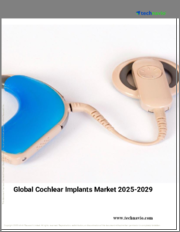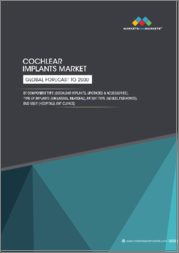
|
시장보고서
상품코드
1620340
세계의 인공와우 시장 규모 : 인공와우 유형별, 최종사용자별, 지역별, 범위 및 예측Global Cochlear Implant Market Size By Type of Cochlear Implant (Unilateral Cochlear Implants, Bilateral Cochlear Implants), By End-User (Adults, Pediatrics), By Geographic Scope And Forecast |
||||||
인공와우 시장 규모와 예측
인공와우 시장 규모는 2023년에 92억 6,000만 달러로 평가되며, 2024-2031년 16.40%의 CAGR로 성장하며, 2031년에는 312억 달러에 달할 것으로 예측됩니다. 인공와우는 중등도에서 중증의 난청 환자에게 소리를 제공하는 전기 장비입니다. 소리를 강화하는 일반적인 보청기와 달리 인공 와우는 귀의 손상된 부분이 아닌 청각 신경을 직접 자극합니다. 이 보청기는 외부의 소리를 포착하는 부품과 소리 신호를 전기적 임펄스로 변환하는 외과 적으로 이식된 내부 부품으로 구성됩니다.
인공와우의 용도는 전형적인 이용 사례를 넘어서고 있습니다. 이전에는 중증에서 고도 난청에 국한되어 있었지만, 새로운 개발로 중등도 난청 환자, 특히 소아에게도 사용할 수 있게 되었습니다. 이러한 확장으로 인해, 후기 치료의 혜택을 받을 수 있는 성인을 포함하여 대상 시장이 확대되고, 희망자가 증가하고 있습니다.
인공와우의 미래는 난청인의 접근성을 향상시키는 청각 기술의 큰 진보를 약속합니다. 전극 설계와 무선 연결의 개선으로 음질과 사용 편의성이 향상될 것으로 예상됩니다. 또한 인공지능과 머신러닝의 발전으로 다양한 청각 환경에 적응하는 개인화된 음향 처리가 가능해질 수 있습니다.
세계의 인공와우 시장 역학
세계 인공와우 시장을 형성하는 주요 시장 역학
주요 시장 성장 촉진요인
청력 손실 유병률 증가 :
난청 유병률 증가: 난청은 전 세계에서, 특히 노인들 사이에서 점점 더 흔해지고 있습니다. 소음 공해, 귀 독성 약물, 유전적 소인이 모두 이 질환의 발병에 기여하고 있습니다. 인구 고령화로 인해 인공와우와 같은 효과적인 청력 솔루션에 대한 수요가 급격히 증가하고 있습니다. 이러한 세대교체는 의료 전문가들이 다양한 정도의 난청을 가진 사람들 수요를 충족시키기 위해 노력하면서 시장 확대에 힘을 실어주고 있습니다.
기술의 진보 :
보청기 기술의 끊임없는 발전은 보청기의 효과와 유용성을 향상시키고 있습니다. 최신 장비는 더 나은 음향 처리 기능, 다른 오디오 장비와의 호환성, 무선통신 기능 등을 갖추고 있으며, 사용자들에게 더욱 매력적입니다. 또한 연구개발 노력의 결과로 최소 침습적 수술 방법과 간소화된 이식 과정이 개발되어 회복 시간을 단축하고 치료 결과를 개선하고 있습니다.
인지도 및 수용도 향상:
인공와우는 교육적 노력과 사용자들의 성공사례를 통해 고도 난청을 위한 효과적인 대안으로 널리 인식되고 있습니다. 특히 난청 환자들에게 기존 보청기를 대체할 수 있는 효과적인 대안으로 인공와우를 추천하는 의료 전문가들이 늘고 있습니다. 이러한 인식의 변화로 인공와우의 수용률과 채택률이 높아지면서 다양한 환자층에서 인공와우에 대한 수요가 증가하고 있습니다.
주요 과제
높은 비용과 상환 문제 :
주요 장애물 중 하나는 인공와우와 수술에 드는 높은 비용입니다. 경제적 부담은 잠재적인 후보자가이 삶을 변화시키는 개입을 추구하는 것을 방해할 수 있습니다. 많은 의료 시스템이 보상을 제공하지만, 국가마다 보험 적용 범위가 다르기 때문에 접근성에 차이가 있을 수 있습니다. 청각 치료 및 임플란트 후 관리에 대한 충분한 상환율이 없기 때문에 의료진이 이러한 장비를 추천하는 것을 주저할 수 있습니다.
환자의 인식 및 수용:
또 다른 문제는 환자와 의료진의 인공와우에 대한 인식과 이해 부족입니다. 많은 난청 환자들이 보청기의 이점을 알지 못하거나 보청기의 효과와 안전성에 대해 오해하고 있을 수 있습니다. 또한 난청과 보청기 사용에 대한 문화적 관점은 특히 수술적 치료보다 보청기를 선호하는 지역에서 보청기의 수용성에 영향을 미칠 수 있습니다.
기술의 발전과 경쟁:
기업은 경쟁력을 유지하기 위해 주기적으로 기술 혁신을 해야 하므로 빠른 기술 향상도 장애물이 될 수 있습니다. 여기에는 음질 향상, 기기 소형화, 배터리 수명 연장 등이 포함됩니다. 유전자 치료 및 기타 청력 회복 기술과 같은 새로운 경쟁자 및 대체 치료법의 진입은 시장 점유율을 더욱 떨어뜨릴 수 있으며, 기존 기업에게는 비용과 시간이 많이 소요되는 연구개발에 대한 지출이 더 큰 압박이 될 수 있습니다.
주요 동향 :
기술의 진보 :
보청기 기술의 끊임없는 발전은 중요한 추세입니다. 최신 장비는 향상된 음향 처리 능력, 고급 무선 연결성, 스마트폰 용도과의 상호 운용성을 갖추고 있습니다. 이러한 발전은 더 나은 청각 경험과 사용자 편의성을 향상시킬 수 있습니다. 또한 음향 증폭과 인공와우 자극을 결합한 하이브리드 인공와우 개발이 인기를 끌고 있으며, 보다 다양한 청각 장애에 대응하고 환자의 예후를 개선하고 있습니다.
인식 제고 및 조기 진단 :
청력 손실과 인공와우의 이점에 대한 인식이 높아지면서 조기 진단이 증가하고 있습니다. 의료 단체의 공중 보건 캠페인과 활동은 지역 사회에 청력 손실, 특히 젊은 층의 청력 손실에 대처할 필요성을 인식시키고 있습니다. 더 많은 사람들이 조기 개입의 이점을 이해함에 따라 인공와우에 대한 수요가 증가하고 시장 성장에 박차를 가할 것으로 예상됩니다.
확대되는 용도 및 환자층:
인공와우의 용도는 전형적인 이용 사례를 넘어서고 있습니다. 기존에는 중증 난청 환자들에게만 제한적으로 사용되었지만, 새로운 개발로 인해 중등도 난청 환자, 특히 어린이들에게도 사용할 수 있게 되었습니다. 이러한 확장으로 인해, 치료의 혜택을 받을 수 있는 성인을 포함하여 대상 시장이 확대되고, 희망자가 증가하고 있습니다.
목차
제1장 서론
- 시장의 정의
- 시장 세분화
- 조사 방법
제2장 개요
- 주요 조사 결과
- 시장 개요
- 시장 하이라이트
제3장 시장 개요
- 시장 규모와 성장 가능성
- 시장 동향
- 시장 성장 촉진요인
- 시장 성장 억제요인
- 시장 기회
- Porter's Five Forces 분석
제4장 인공와우 시장 : 인공와우 유형별
- 편이 인공와우
- 양이 인공와우
제5장 인공와우 시장 : 최종사용자별
- 성인
- 소아
제6장 지역별 분석
- 북미
- 미국
- 캐나다
- 멕시코
- 유럽
- 영국
- 독일
- 프랑스
- 이탈리아
- 아시아태평양
- 중국
- 일본
- 인도
- 호주
- 라틴아메리카
- 브라질
- 아르헨티나
- 칠레
- 중동 및 아프리카
- 남아프리카공화국
- 사우디아라비아
- 아랍에미리트
제7장 시장 역학
- 시장 성장 촉진요인
- 시장 성장 억제요인
- 시장 기회
- 시장에 대한 COVID-19의 영향
제8장 경쟁 구도
- 주요 기업
- 시장 점유율 분석
제9장 기업 개요
- Cochlear Limited
- MED-EL
- Advanced Bionics(Sonova)
- Nurotron Biotechnology Co., Ltd.
- Oticon Medical
- William Demant Holding A/S
- Sivantos Pvt. Ltd.(WS Audiology)
- GN Hearing A/S
제10장 시장 전망과 기회
- 신규 기술
- 향후 시장 동향
- 투자 기회
제11장 부록
- 약어 리스트
- 전시와 참고 문헌
Cochlear Implant Market Size And Forecast
Cochlear Implant Market Size was valued at USD 9.26 Billion in 2023 and is projected to reach USD 31.2 Billion by 2031, growing at a CAGR of 16.40% from 2024 to 2031. Cochlear implants are electrical devices that give sound to those who have severe to profound hearing loss. Unlike typical hearing aids which enhance sound, cochlear implants stimulate the auditory nerve directly rather than the damaged sections of the ear. The gadget is made up of an external sound-capturing component and a surgically implanted interior component that converts sound signals into electrical impulses.
The uses of cochlear implants are moving beyond their typical use cases. Previously limited to severe to profound hearing loss, new developments enable the devices to be utilized in people with moderate hearing loss, notably in children. This expansion broadens the target market attracting an increasing number of applicants including adults who may benefit from late-stage therapies.
The future of cochlear implants promises major advances in auditory technology increasing accessibility for those with hearing loss. Improvements in electrode design and wireless connectivity are expected to increase sound quality and ease of usage. Furthermore, advances in artificial intelligence and machine learning may enable personalized sound processing that adapts to different hearing settings.
Global Cochlear Implant Market Dynamics
The key market dynamics that are shaping the global Cochlear Implant Market include:
Key Market Drivers:
Rising Prevalence of Hearing Loss:
Hearing loss is becoming more common worldwide, especially among the elderly. Noise pollution, ototoxic drugs, and genetic predispositions all play a role in this development. As the population ages, the demand for effective hearing solutions such as cochlear implants, rises dramatically. This generational shift propels market expansion as healthcare professionals strive to meet the demands of people with various degrees of hearing loss.
Advancements in Technology:
Continuous advances in cochlear implant technology improve its effectiveness and usefulness. Modern gadgets include better sound processing capabilities compatibility with other audio devices, and wireless communication features making them more enticing to users. Furthermore, research and development efforts have resulted in the creation of minimally invasive surgical techniques and streamlined implantation processes which shorten recovery times and improve outcomes.
Increasing Awareness and Acceptance:
Cochlear implants are becoming more widely recognised as a viable option for profound hearing loss, thanks to educational initiatives and user success stories. Healthcare professionals are increasingly advocating cochlear implants as an effective alternative to traditional hearing aids, particularly for people who have profound hearing loss. This shift in perception boosts acceptance and adoption rates, resulting in increased demand for cochlear implants among various patient demographics.
Key Challenges:
High Costs and Reimbursement Issues:
One of the key obstacles is the high expense of cochlear implants and surgical procedures. The financial burden may dissuade potential candidates from seeking this life-changing intervention. While many healthcare systems offer compensation, differences in insurance coverage between countries might result in discrepancies in access. Insufficient reimbursement rates for audiological treatments and post-implant care may deter healthcare practitioners from recommending these devices.
Patient Awareness and Acceptance:
Another issue is lack of awareness and comprehension of cochlear implants among patients and healthcare providers. Many people with hearing loss may be ignorant of the advantages of cochlear implants or have misconceptions about their efficacy and safety. Furthermore, cultural views about hearing loss and the use of hearing devices can influence acceptability, especially in areas where hearing aids are preferred over surgical treatments.
Technological Advancements and Competition:
Rapid technological improvements also present a hurdle, since firms must innovate on a regular basis to remain competitive. This includes boosting sound quality decreasing device size, and increasing battery life. The entrance of new competitors and alternative treatments such as gene therapy and other hearing restoration technologies may further erode market share and put more pressure on existing companies to spend in R&D which may be costly and time-consuming.
Key Trends:
Technological Advancements:
Continuous advancement in cochlear implant technology is a significant trend. Modern devices have enhanced sound processing capabilities, advanced wireless connectivity, and interoperability with smartphone applications. These developments allow for better aural experiences and increased user convenience. Furthermore, the development of hybrid cochlear implants which combine acoustic amplification and cochlear stimulation is gaining popularity addressing a larger variety of hearing disorders and improving patient outcomes.
Rising Awareness and Early Diagnosis:
There is a growing awareness of hearing loss and the benefits of cochlear implants, resulting in increased early diagnosis. Healthcare organizations' public health campaigns and activities educate communities about the need to address hearing loss, particularly among youngsters. As more people understand the benefits of early intervention, demand for cochlear implants is likely to increase, adding to market growth.
Expanding Applications and Patient Demographics:
The uses of cochlear implants are moving beyond their typical use cases. Previously limited to severe to profound hearing loss, new developments enable the devices to be utilized in people with moderate hearing loss, notably in children. This expansion broadens the target market attracting an increasing number of applicants including adults who may benefit from late-stage therapies.
What's inside a VMR industry report?
Our reports include actionable data and forward-looking analysis that help you craft pitches, create business plans, build presentations and write proposals.
Global Cochlear Implant Market Regional Analysis
Here is a more detailed regional analysis of the global Cochlear Implant Market:
North America:
North America is dominant in the Cochlear Implant Market owing to its advanced healthcare infrastructure and large investments in R&D. The region is home to several premier medical technology companies that focus on innovative auditory solutions resulting in the development of cutting-edge cochlear implants. Furthermore, the availability of qualified healthcare personnel and specialised audiology centres leads to the increased adoption of cochlear implants.
Furthermore, as people become more aware of the impact of hearing loss on their quality of life, there is a greater desire for early intervention and effective treatment alternatives. Government measures, insurance coverage, and patient support programs all improve access to cochlear implants. The emphasis on enhanced healthcare outcomes as well as the integration of cochlear implants with sophisticated technologies such as telemedicine and remote monitoring are moving the market ahead and strengthening North America's position as a cochlear implant industry leader.
Asia-Pacific:
The Asia Pacific is the fastest-growing region in the Cochlear Implant Market due to several factors, including an increasing prevalence of hearing loss and improved knowledge of advanced auditory solutions. The region's big population along with an aging demographic adds to a higher rate of hearing impairment. Furthermore, increased awareness and acceptance of cochlear implants among healthcare professionals and patients is resulting in more diagnoses and treatments.
Furthermore, government actions to improve healthcare infrastructure and access to innovative medical technologies have a substantial impact on the adoption of cochlear implants. Countries such as China and India are investing in healthcare reforms and expanding their insurance coverage to include cochlear implants making them more accessible to the public. The presence of large medical device manufacturers in the region also facilitates the development of innovative products drives competition, and lowers cost resulting in market expansion in the Asia Pacific cochlear implant sector.
Global Cochlear Implant Market Segmentation Analysis
The Global Cochlear Implant Market is Segmented on the basis of Type of Cochlear Implant, End-User, and Geography.
Cochlear Implant Market, By Type of Cochlear Implant
- Unilateral Cochlear Implants
- Bilateral Cochlear Implants
Based on the Type of Cochlear Implant, the Global Cochlear Implant Market is bifurcated into Unilateral Cochlear Implants and Bilateral Cochlear Implants. Unilateral cochlear implants are more dominant in the Cochlear Implant Market due to their effectiveness in treating single-sided deafness, which is prevalent among patients. They offer significant improvements in sound localization and speech perception making them a practical choice for many individuals. Additionally, the surgical procedure is less complex compared to bilateral implants resulting in shorter recovery times and lower costs. Growing awareness of hearing loss and advancements in implant technology further contribute to the increasing adoption of unilateral cochlear implants.
Cochlear Implant Market, By End User
- Adults
- Pediatrics
Based on End-User, the Global Cochlear Implant Market is bifurcated into Adults and Pediatrics. Pediatrics is more dominant in the Cochlear Implant Market due to the critical importance of early intervention in children with hearing loss. Early implantation significantly improves language development, cognitive skills, and social integration, leading to better long-term outcomes. Furthermore, pediatric cochlear implants have become increasingly accepted among healthcare providers and families driven by advancements in technology that ensure safety and efficacy. Additionally, ongoing support from healthcare policies and initiatives aimed at enhancing childhood hearing health further boosts market demand in this segment.
Cochlear Implant Market, By Geography
- North America
- Europe
- Asia Pacific
- Rest of the world
Based on Geography, the Global Cochlear Implant Market is classified into North America, Europe, Asia Pacific, and the Rest of the world. North America dominates the Cochlear Implant Market due to its advanced healthcare infrastructure and high levels of investment in medical technology. Strong support from government and private organizations promotes research and development, leading to innovative implant solutions. Additionally, high awareness of hearing disorders and early diagnosis contribute to increased demand for cochlear implants. The presence of key manufacturers and robust reimbursement policies further enhance market growth making North America a leader in the cochlear implant industry.
Key Players
- The "Global Cochlear Implant Market" study report will provide valuable insight with an emphasis on the global market. The major players in the market are
- Cochlear Limited, MED-EL, Advanced Bionics, Nurotron Biotechnology Co., Ltd., Oticon Medical, William Demant Holding A/S, Sivantos Pvt. Ltd. (WS Audiology), and GN Hearing A/S.
Our market analysis also entails a section solely dedicated to such major players wherein our analysts provide an insight into the financial statements of all the major players, along with product benchmarking and SWOT analysis.
Global Cochlear Implant Market Key Developments
- In March 2023, MED-EL Medical Electronics provided direct streaming to their cochlear implant patient in their new MED-EL cochlear implant systems.
- In November 2022, Cochlear Ltd. expanded its manufacturing facility plant in Kuala Lumpur, Malaysia. The expansion involved an asset of more than USD 6.28 million (RM 30 million) to help the growing demand for acoustic and cochlear hearing implants.
TABLE OF CONTENTS
1. Introduction
- Market Definition
- Market Segmentation
- Research Methodology
2. Executive Summary
- Key Findings
- Market Overview
- Market Highlights
3. Market Overview
- Market Size and Growth Potential
- Market Trends
- Market Drivers
- Market Restraints
- Market Opportunities
- Porter's Five Forces Analysis
4. Cochlear Implant Market, By Type of Cochlear Implant
- Unilateral Cochlear Implants
- Bilateral Cochlear Implants
5. Cochlear Implant Market, By End-User
- Adults
- Pediatrics
6. Regional Analysis
- North America
- United States
- Canada
- Mexico
- Europe
- United Kingdom
- Germany
- France
- Italy
- Asia-Pacific
- China
- Japan
- India
- Australia
- Latin America
- Brazil
- Argentina
- Chile
- Middle East and Africa
- South Africa
- Saudi Arabia
- UAE
7. Market Dynamics
- Market Drivers
- Market Restraints
- Market Opportunities
- Impact of COVID-19 on the Market
8. Competitive Landscape
- Key Players
- Market Share Analysis
9. Company Profiles
- Cochlear Limited
- MED-EL
- Advanced Bionics (Sonova)
- Nurotron Biotechnology Co., Ltd.
- Oticon Medical
- William Demant Holding A/S
- Sivantos Pvt. Ltd. (WS Audiology)
- GN Hearing A/S
10. Market Outlook and Opportunities
- Emerging Technologies
- Future Market Trends
- Investment Opportunities
11. Appendix
- List of Abbreviations
- Sources and References



















